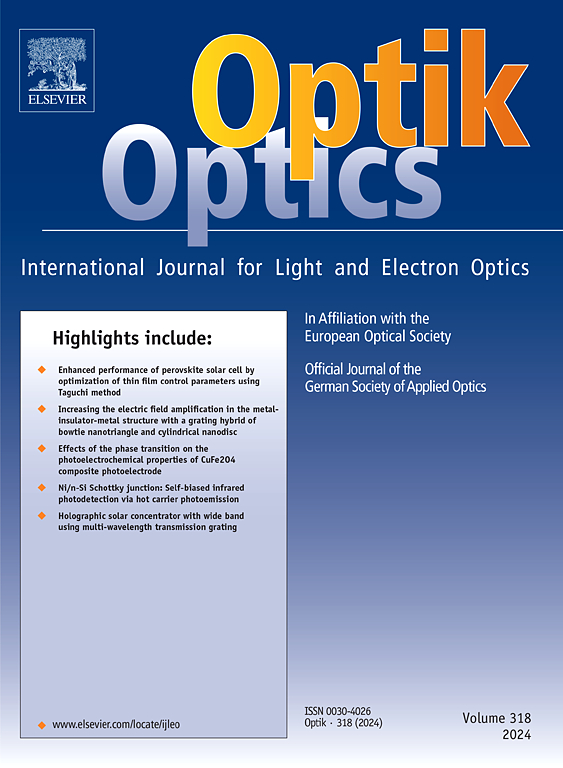一种优化空间调制全偏振成像系统滤波器带宽的方法
IF 3.1
3区 物理与天体物理
Q2 Engineering
引用次数: 0
摘要
本研究提出了一种基于仿真干扰水印条纹的最优滤波器带宽计算方法,以保持空间调制全偏振成像系统在不同目标场景下的最优性能,为系统成像镜头的选型提供一定的理论指导。将仿真干涉水印条纹的二维正弦函数叠加在强度图像上,利用快速傅立叶变换和频域低通滤波算法对仿真干涉图进行解调,得到全偏振图像。然后,求解与强度图像结构相似度最高的偏振图像,提出了一种基于改进的精英克隆选择算法(ECSA)的最优滤波器带宽计算方法。然后,结合不同目标场景下选取的图像分辨率、入射光波长和Savart偏振镜单束偏移量,计算成像透镜的最佳焦距,完成理论选型。实验结果表明,基于最优滤波器带宽构建的空间调制全偏振成像系统具有良好的性能;与经验类型选择相比,基于最优滤波器带宽的类型选择使光谱反演面积增加4.2倍,图像结构相似度提高71 %,显著提高了系统的偏振成像质量。本文章由计算机程序翻译,如有差异,请以英文原文为准。
A method of optimising the filter bandwidth of a spatially modulated full-polarisation imaging system
In this study, a method of calculating the optimal filter bandwidth based on the watermark fringes of simulation interference was proposed to maintain the optimal performance of a spatially modulated full-polarisation imaging system in different target scenes, offering some theoretical guidance for the type selection of the imaging lens for the system. The two-dimensional sine function of the watermark fringes of simulation interference was superimposed on the intensity image, and a full-polarisation image was obtained by demodulating the simulation interferogram using the fast Fourier transform and the frequency-domain low-pass-filtering algorithm. Then, the polarisation image with the highest structural similarity to the intensity image was solved, and a method of calculating the optimal filter bandwidth based on the improved elitist clonal selection algorithm (ECSA) was presented. Next, the optimal focal length of the imaging lens was calculated in combination with the image resolutions, incident light wavelengths, and Savart polariser single-beam offsets selected in different target scenes, to complete the theoretical type selection. The experimental results showed that the spatially modulated full-polarisation imaging system constructed based on the optimal filter bandwidth had a good performance; and that, compared with empirical type selection, the proposed type selection based on the optimal filter bandwidth increased the spectral inversion area by 4.2 times and the image structural similarity by 71 %, significantly improving the polarisation imaging quality of the system.
求助全文
通过发布文献求助,成功后即可免费获取论文全文。
去求助
来源期刊

Optik
物理-光学
CiteScore
6.90
自引率
12.90%
发文量
1471
审稿时长
46 days
期刊介绍:
Optik publishes articles on all subjects related to light and electron optics and offers a survey on the state of research and technical development within the following fields:
Optics:
-Optics design, geometrical and beam optics, wave optics-
Optical and micro-optical components, diffractive optics, devices and systems-
Photoelectric and optoelectronic devices-
Optical properties of materials, nonlinear optics, wave propagation and transmission in homogeneous and inhomogeneous materials-
Information optics, image formation and processing, holographic techniques, microscopes and spectrometer techniques, and image analysis-
Optical testing and measuring techniques-
Optical communication and computing-
Physiological optics-
As well as other related topics.
 求助内容:
求助内容: 应助结果提醒方式:
应助结果提醒方式:


